wheel alignment NISSAN PULSAR 1987 Workshop Manual
[x] Cancel search | Manufacturer: NISSAN, Model Year: 1987, Model line: PULSAR, Model: NISSAN PULSAR 1987Pages: 238, PDF Size: 28.91 MB
Page 4 of 238
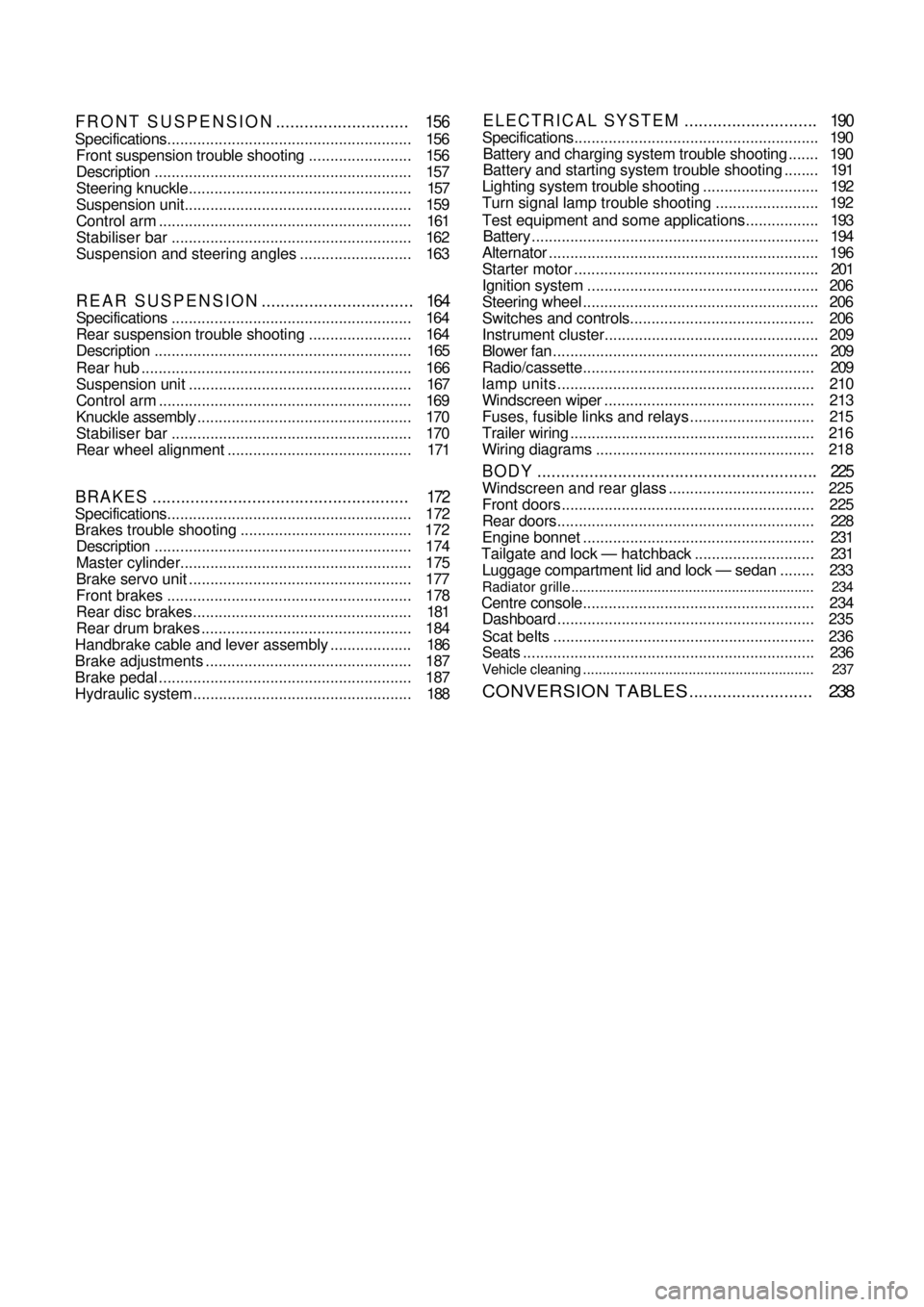
FRONT SUSPENSION............................ 156
Specifications......................................................... 156
Front suspension tr ouble shooting ........................ 156
Description ............................................................ 157
Steering knuckle.................................................... 157
Suspension unit..................................................... 159
Control arm ........................................................... 161
Stabiliser bar ........................................................ 162
Suspension and steering angles .......................... 163
REAR SUSPENSION................................ 164
Specifications ........................................................ 164
Rear suspension tr ouble shooting ........................ 164
Description ............................................................ 165
Rear hub ............................................................... 166
Suspension unit .................................................... 167
Control arm ........................................................... 169
Knuckle assembly.................................................. 170
Stabiliser bar ........................................................ 170
Rear wheel alignment ........................................... 171
BRAKES...................................................... 172
Specifications......................................................... 172
Brakes trouble shooting ........................................ 172
Description ............................................................ 174
Master cyli nder...................................................... 175
Brake servo unit .................................................... 177
Front brakes ......................................................... 178
Rear disc brakes................................................... 181
Rear drum brakes ................................................. 184
Handbrake cable and le ver assembly ................... 186
Brake adjustments ................................................ 187
Brake pedal ........................................................... 187
Hydraulic system................................................... 188
ELECTRICAL SYSTEM............................ 190
Specifications......................................................... 190
Battery and charging system trouble shooting ....... 190
Battery and starting system trouble shooting ........ 191
Lighting system trouble shooting ........................... 192
Turn signal lamp trouble shooting ........................ 192
Test equipment and so me applications................. 193
Battery ................................................................... 194
Alternator ............................................................... 196
Starter motor ......................................................... 201
Ignition system ...................................................... 206
Steering wheel ....................................................... 206
Switches and controls........................................... 206
Instrument cluster.................................................. 209
Blower fan .............................................................. 209
Radio/cassette...................................................... 209
lamp units ............................................................ 210
Windscreen wiper ................................................. 213
Fuses, fusible links and relays ............................. 215
Trailer wiring ......................................................... 216
Wiring diagrams ................................................... 218
BODY........................................................... 225
Windscreen and re ar glass .................................. 225
Front doors ........................................................... 225
Rear doors............................................................ 228
Engine bonnet...................................................... 231
Tailgate and lock — hatchback ............................ 231
Luggage compartment lid and lock — sedan ........ 233
Radiator grille.............................................................. 234
Centre console...................................................... 234 Dashboard ............................................................ 235
Scat belts ............................................................. 236
Seats .................................................................... 236
Vehicle cleaning ........................................................... 237
CONVERSION TABLES.......................... 238
Page 22 of 238

22 Wheels and Tires
View of the jack correctly installed to the front jacking point
.
(10) Continue to raise the jack until the tire
clears the ground sufficiently to allow the spare wheel
to be installed.
(11) Remove the wheel nuts and lift the wheel
off the hub.
NOTE: Under no circumstances get under
the vehicle while the jack is the only means
of support.
(12) Install the spare wh eel and install the wheel
nuts with the chamfered e nds contacting the wheels.
Tighten the wheel nuts as much as possible by hand.
(13) Lower the jack and securely tighten the
wheel nuts progressively in a diagonal sequence using
the wheel spanner. (14) Where removed, install the wheel cover.
(15) Return the spare wheel, jack and tool kit to
their relevant storage positions.
ABNORMAL WEAR ON CENTRE OF TREAD
(1) Over inflation of tires: Check and reduce to
the recommended pressure.
ABNORMAL WEAR ON INSIDE OF TREAD
(1) Excessive negative camber angle: Check the
wheel alignment. (2) Sagging coil springs: Check and renew the
coil springs as a pair. (3) Loose or worn hub bearing assembly: Check
and renew the hub bearing assembly. (4) Bent, loose or worn suspension components:
Check and renew any faulty components.
ABNORMAL WEAR ON OUTSIDE OF TREAD
(1) Excessive positive camber: Check the front
wheel alignment.
(2) Excessive speed when cornering: Revise driv-
ing habits. (3) Bent, loose or worn suspension components:
Check and renew any faulty components.
2. TYRE WEAR TROUBLE SHOOTING
ABNORMAL WEAR ON BOTH SIDES OF
TREAD
(1) Under inflation of tires: Check and inflate to
the recommended pressure.
(2) Overloading: Reduce the maximum loading. FLAT SPOTS ON TREAD OR IRREGULAR
WEAR
(1)
Static or dynamic unbalance of the wheel
and tire assembly: Check the balance of the wheel and
tire assembly. (2) Lateral run out of the wheel: Check and (rue
up or renew the wheel.
Tighten the wheel nuts in a diagonal sequence using
the wheel spanner.
Page 23 of 238
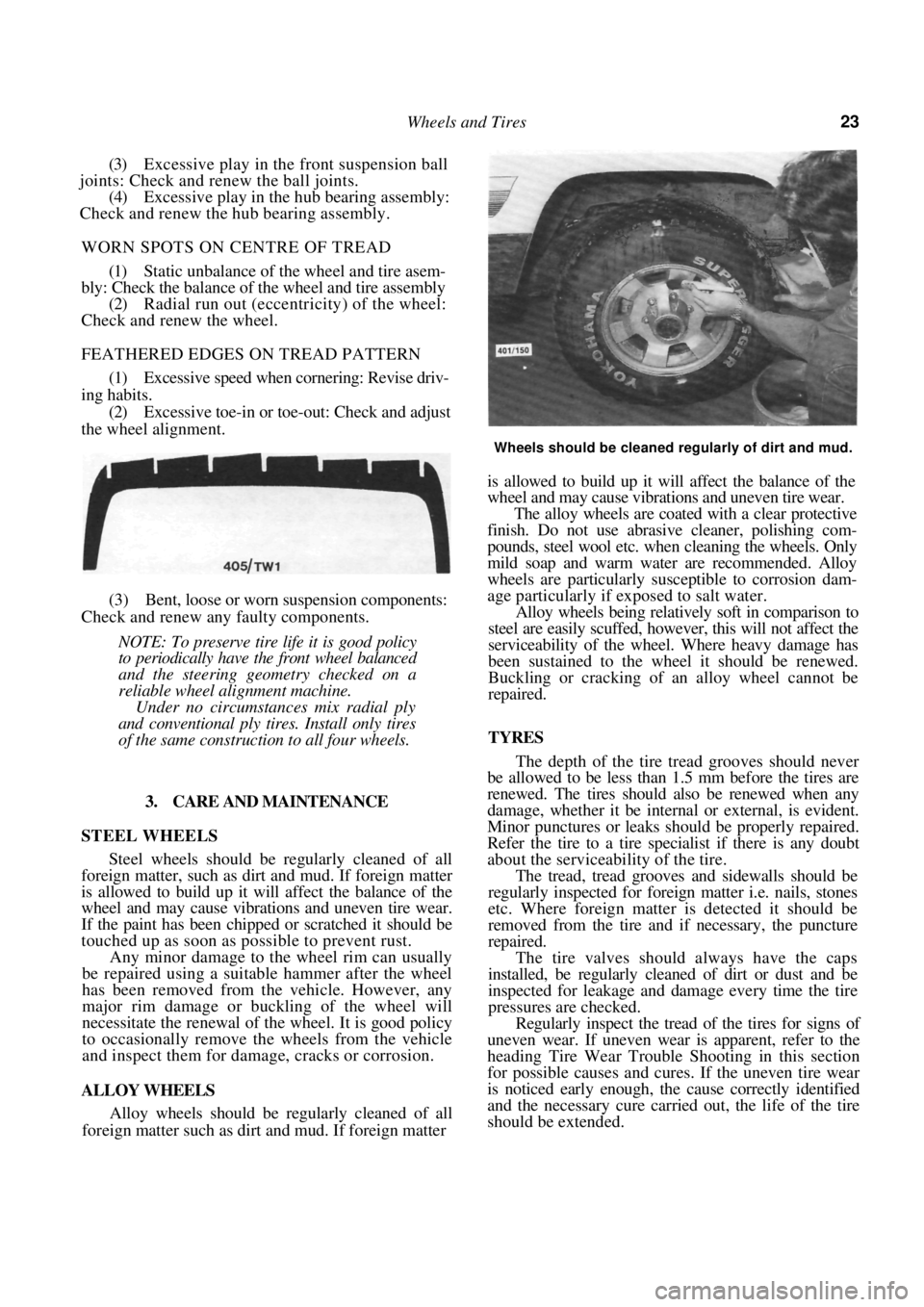
Wheels and Tires 23
(3) Excessive play in the front suspension ball
joints: Check and renew the ball joints.
(4) Excessive play in the hub bearing assembly:
Check and renew the hub bearing assembly.
WORN SPOTS ON CENTRE OF TREAD
(1) Static unbalance of the wheel and tire asem-
bly: Check the balance of the wheel and tire assembly
(2) Radial run out (eccentricity) of the wheel:
Check and renew the wheel.
FEATHERED EDGES ON TREAD PATTERN
(1) Excessive speed when cornering: Revise driv-
ing habits. (2) Excessive toe-in or toe-out: Check and adjust
the wheel alignment.
(3) Bent, loose or worn suspension components:
Check and renew any faulty components.
NOTE: To preserve tire life it is good policy
to periodically have the front wheel balanced
and the steering geometry checked on a
reliable wheel alignment machine.
Under no circumstances mix radial ply
and conventional ply tire s. Install only tires
of the same construction to all four wheels.
3. CARE AND MAINTENANCE
STEEL WHEELS
Steel wheels should be regularly cleaned of all
foreign matter, such as dirt and mud. If foreign matter
is allowed to build up it will affect the balance of the
wheel and may cause vibrations and uneven tire wear.
If the paint has been chipped or scratched it should be
touched up as soon as possible to prevent rust.
Any minor damage to the wheel rim can usually
be repaired using a suitable hammer after the wheel
has been removed from the vehicle. However, any
major rim damage or buckling of the wheel will
necessitate the renewal of the wheel. It is good policy
to occasionally remove the wheels from the vehicle
and inspect them for damage, cracks or corrosion.
ALLOY WHEELS
Alloy wheels should be regularly cleaned of all
foreign matter such as dirt and mud. If foreign matter
Wheels should be cleaned regularly of dirt and mud.
is allowed to build up it will affect the balance of the
wheel and may cause vibrations and uneven tire wear.
The alloy wheels are coated with a clear protective
finish. Do not use abrasive cleaner, polishing com-
pounds, steel wool etc. when cleaning the wheels. Only
mild soap and warm wate r are recommended. Alloy
wheels are particularly su sceptible to corrosion dam-
age particularly if exposed to salt water.
Alloy wheels being relatively soft in comparison to
steel are easily scuffed, however, this will not affect the
serviceability of the wheel. Where heavy damage has
been sustained to the wheel it should be renewed.
Buckling or cracking of an alloy wheel cannot be
repaired.
TYRES
The depth of the tire tread grooves should never
be allowed to be less than 1.5 mm before the tires are
renewed. The tires should also be renewed when any
damage, whether it be internal or external, is evident.
Minor punctures or leaks s hould be properly repaired.
Refer the tire to a tire spec ialist if there is any doubt
about the serviceability of the tire.
The tread, tread grooves and sidewalls should be
regularly inspected for foreign matter i.e. nails, stones
etc. Where foreign matter is detected it should be
removed from the tire and if necessary, the puncture
repaired.
The tire valves should always have the caps
installed, be regularly cleaned of dirt or dust and be
inspected for leakage and damage every time the tire
pressures are checked.
Regularly inspect the tread of the tires for signs of
uneven wear. If uneven wear is apparent, refer to the
heading Tire Wear Trouble Shooting in this section
for possible causes and cures. If the uneven tire wear
is noticed early enough, the cause correctly identified
and the necessary cure carried out, the life of the tire
should be extended.
Page 24 of 238
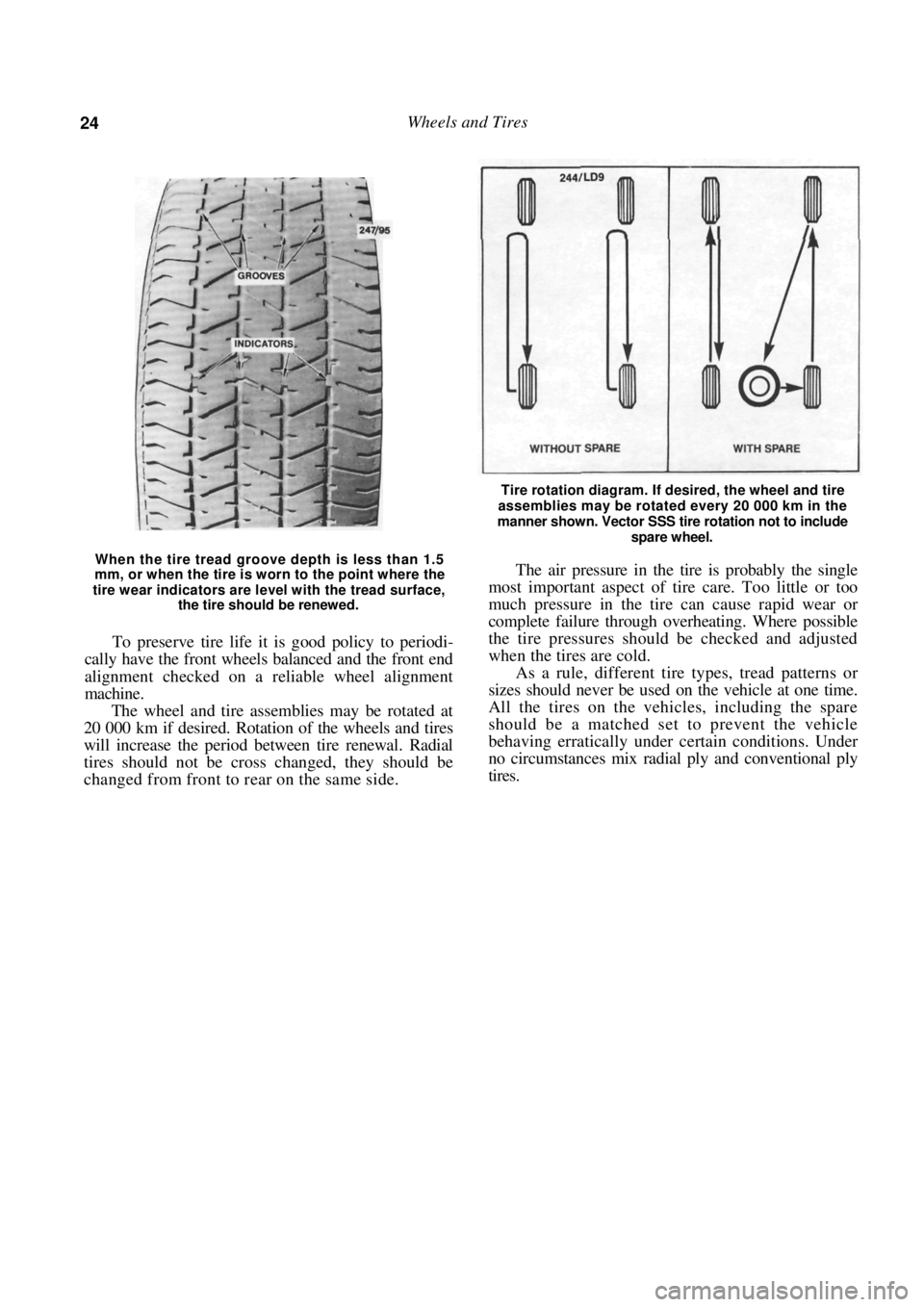
24 Wheels and Tires
When the tire tread groove depth is less than 1.5
mm, or when the tire is worn to the point where the
tire wear indicators are level with the tread surface,
the tire should be renewed.
To preserve tire life it is good policy to periodi-
cally have the front wheels balanced and the front end
alignment checked on a reliable wheel alignment
machine.
The wheel and tire assemblies may be rotated at
20 000 km if desired. Rotation of the wheels and tires
will increase the period between tire renewal. Radial
tires should not be cross changed, they should be
changed from front to rear on the same side.
Tire rotation diagram. If desired, the wheel and tire
assemblies may be rotated every 20 000 km in the
manner shown. Vector SSS tire rotation not to include
spare wheel.
The air pressure in the tire is probably the single
most important aspect of tire care. Too little or too
much pressure in the tire can cause rapid wear or
complete failure through overheating. Where possible
the tire pressures should be checked and adjusted
when the tires are cold.
As a rule, different tire types, tread patterns or
sizes should never be used on the vehicle at one time.
All the tires on the vehicles, including the spare
should be a matched set to prevent the vehicle
behaving erratically under certain conditions. Under
no circumstances mix radial ply and conventional ply
tires.
Page 145 of 238
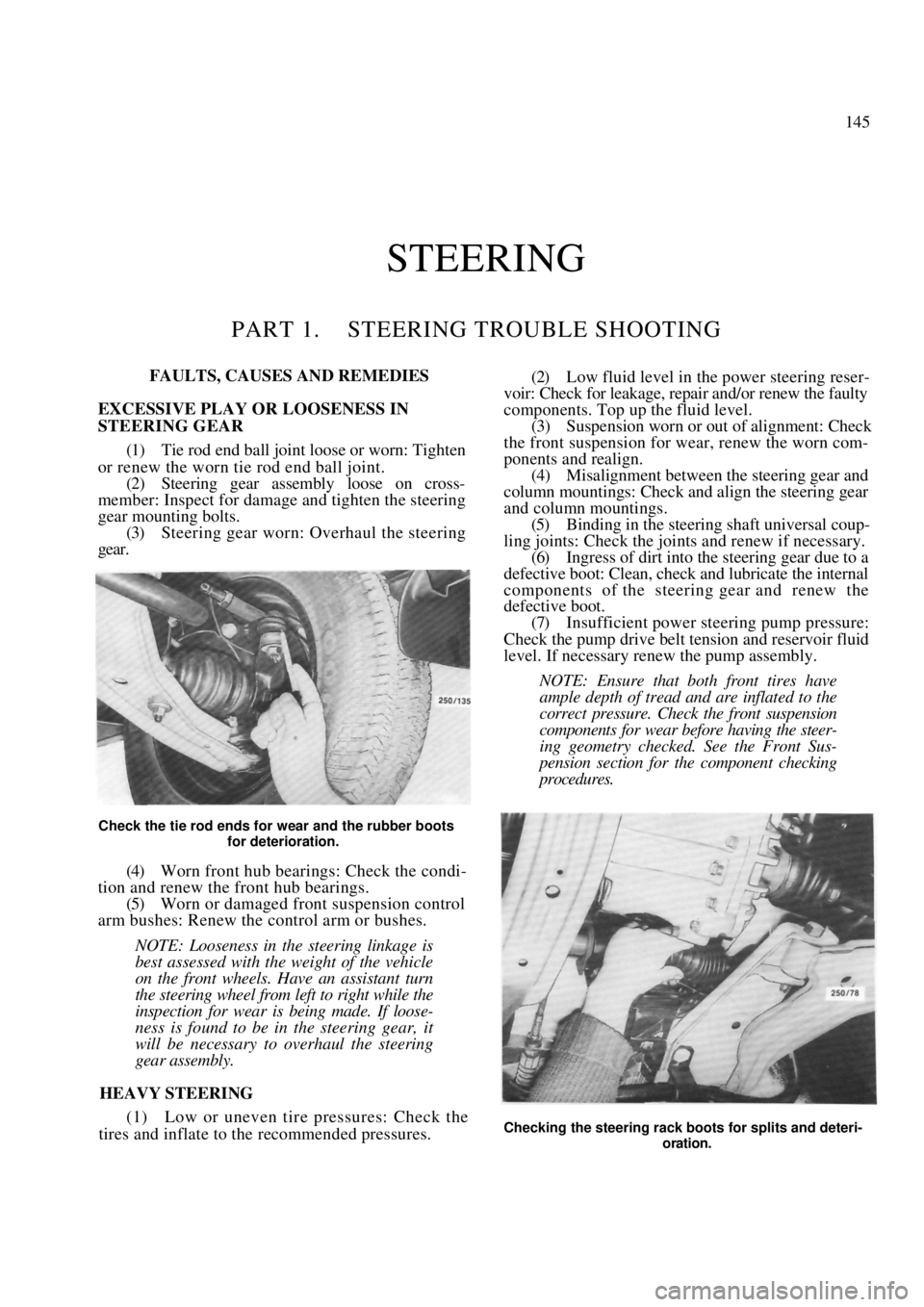
145
STEERING
PART 1. STEERING TROUBLE SHOOTING
FAULTS, CAUSES AND REMEDIES
EXCESSIVE PLAY OR LOOSENESS IN
STEERING GEAR
(1) Tie rod end ball joint loose or worn: Tighten
or renew the worn tie rod end ball joint. (2) Steering gear assembly loose on cross-
member: Inspect for damage and tighten the steering
gear mounting bolts. (3) Steering gear worn: Overhaul the steering
gear.
(2) Low fluid level in the power steering reser-
voir: Check for leakage, repa ir and/or renew the faulty
components. Top up the fluid level.
(3) Suspension worn or out of alignment: Check
the front suspension for wear, renew the worn com-
ponents and realign. (4) Misalignment between the steering gear and
column mountings: Check and align the steering gear
and column mountings. (5) Binding in the steering shaft universal coup-
ling joints: Check the join ts and renew if necessary.
(6) Ingress of dirt into the steering gear due to a
defective boot: Clean, check and lubricate the internal
components of the steering gear and renew the
defective boot. (7) Insufficient power steering pump pressure:
Check the pump drive belt tension and reservoir fluid
level. If necessary renew the pump assembly.
NOTE: Ensure that both front tires have
ample depth of tread and are inflated to the
correct pressure. Check the front suspension
components for wear before having the steer-
ing geometry checked. See the Front Sus-
pension section for the component checking
procedures.
Check the tie rod ends for wear and the rubber boots for deterioration.
(4) Worn front hub bearings: Check the condi-
tion and renew the front hub bearings. (5) Worn or damaged front suspension control
arm bushes: Renew the control arm or bushes.
NOTE: Looseness in th e steering linkage is
best assessed with the weight of the vehicle
on the front wheels. Have an assistant turn
the steering wheel from left to right while the
inspection for wear is being made. If loose-
ness is found to be in the steering gear, it
will be necessary to overhaul the steering
gear assembly.
HEAVY STEERING
(1) Low or uneven tir e pressures: Check the
tires and inflate to the recommended pressures.
Checking the steering rack boot s for splits and deteri-
oration.
Page 146 of 238
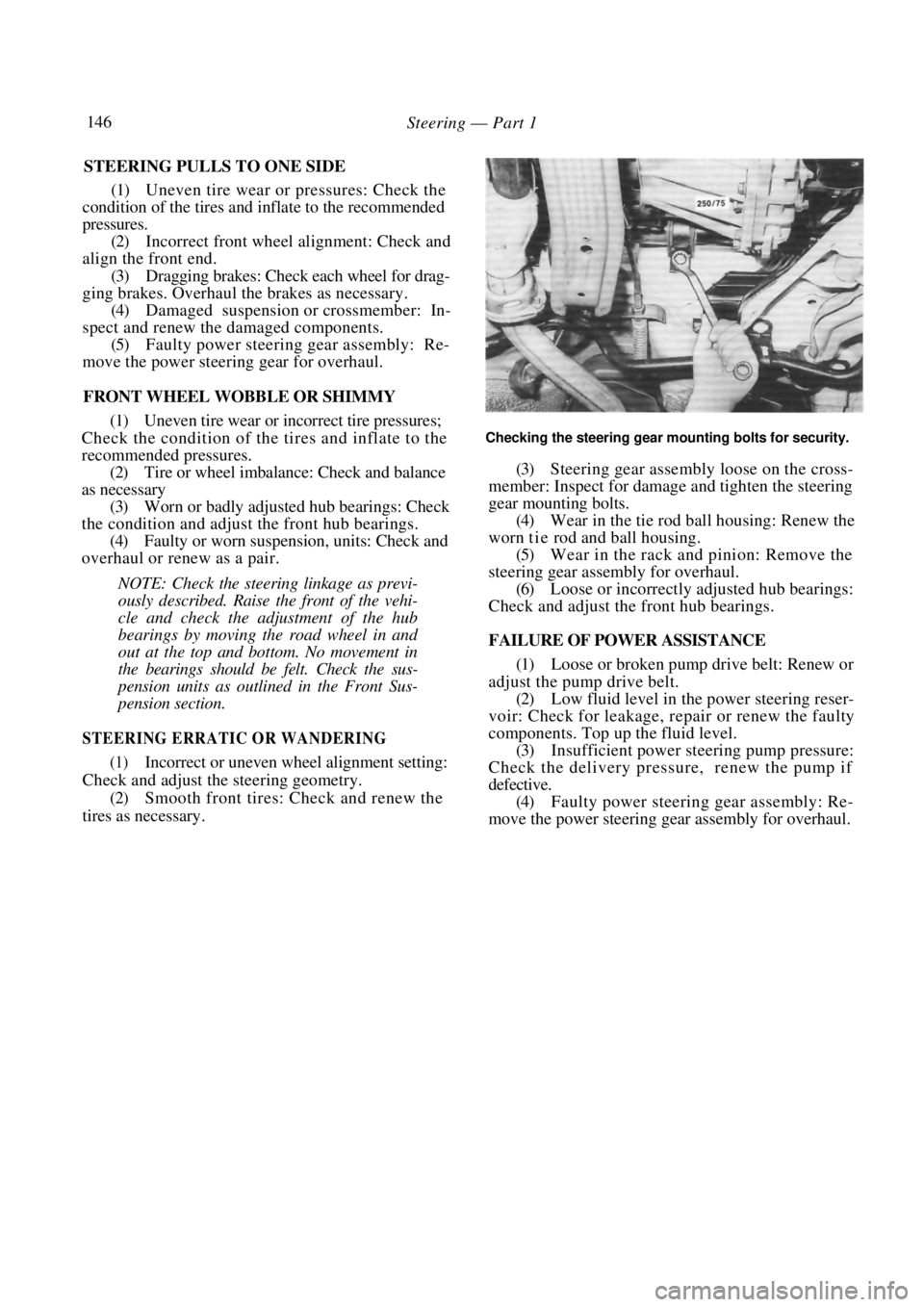
146 Steering — Part 1
STEERING PULLS TO ONE SIDE
(1) Uneven tire wear or pressures: Check the
condition of the tires and inflate to the recommended
pressures.
(2) Incorrect front wheel alignment: Check and
align the front end.
(3) Dragging brakes: Check each wheel for drag-
ging brakes. Overhaul the brakes as necessary. (4) Damaged suspension or crossmember: In-
spect and renew the damaged components. (5) Faulty power steering gear assembly: Re-
move the power steering gear for overhaul.
FRONT WHEEL WOBBLE OR SHIMMY
(1) Uneven tire wear or incorrect tire pressures;
Check the condition of the tires and inflate to the
recommended pressures. (2) Tire or wheel imbalance: Check and balance
as necessary (3) Worn or badly adjusted hub bearings: Check
the condition and adjust the front hub bearings.
(4) Faulty or worn suspension, units: Check and
overhaul or renew as a pair.
NOTE: Check the steering linkage as previ-
ously described. Raise the front of the vehi-
cle and check the adjustment of the hub
bearings by moving the road wheel in and
out at the top and bottom. No movement in
the bearings should be felt. Check the sus-
pension units as outlined in the Front Sus-
pension section.
STEERING ERRATIC OR WANDERING
(1) Incorrect or uneven wheel alignment setting:
Check and adjust th e steering geometry.
(2) Smooth front tires: Check and renew the
tires as necessary.
Checking the steering gear mounting bolts for security.
(3) Steering gear assembly loose on the cross-
member: Inspect for damage and tighten the steering
gear mounting bolts.
(4) Wear in the tie rod ball housing: Renew the
worn t i e rod and ball housing. (5) Wear in the rack and pinion: Remove the
steering gear assembly for overhaul. (6) Loose or incorrectly adjusted hub bearings:
Check and adjust the front hub bearings.
FAILURE OF POWER ASSISTANCE
(1) Loose or broken pump drive belt: Renew or
adjust the pump drive belt.
(2) Low fluid level in the power steering reser-
voir: Check for leakage, repair or renew the faulty
components. Top up the fluid level. (3) Insufficient power steering pump pressure:
Check the delivery pressure, renew the pump if
defective. (4) Faulty power steering gear assembly: Re-
move the power steering gear assembly for overhaul.
Page 156 of 238

156
FRONT SUSPENSION
SPECIFICATIONS
Type.................. Independent MacPherson strut with
coil springs and control arms
Shock absorber .................. Hydraulic, non-repairable
Hub bearing end float (maximum) ............. 0.05 mm
Ball joint axial play (maximum) ....................0.7 mm
Ball joint turning torque (used)...............0.5-4.9 Nm
Wheel alignment:
Toe in ..................................................... 0-2 mm
Camber ........................................- 0 ° 1 0 ' ± 4 5 '
Caster ..............................................1 ° 1 0 ' ± 4 5 '
King pin inclination..................... 1 3 ° 5 5 ' ± 4 5 '
TORQUE WRENCH SETTINGS
Hub bearing nut..................................... 196-235 Nm
Suspension unit to steering knuckle nut ...... 118 Nm
Suspension unit to body nuts ......................... 29 Nm
Piston rod nut .................................................. 72 Nm
Brake caliper to steering knuckle bolts ........... 52 Nm
Ball joint to steering knuckle bolt ................... 86 Nm
Control arm bracket bolts ............................... 98 Nm
Control arm pivot bolt ................................ 118 Nm
Stabiliser bar link nuts..................................... 44 Nm
Stabiliser bar bracket bolts .............................. 21 Nm
1. FRONT SUSPENSION TROUBLE
SHOOTING
FRONT END NOISE
(1) Loose upper suspension mounting or piston
rod: Tighten the mounting or piston rod nuts. (2) Loose or worn suspension unit lower ball
joint: Tighten or renew the lower ball joint.
(3) Noise in the suspension unit: Renew the
faulty suspension unit, preferably in pairs.
(4) Worn or loose steering gear: Overhaul the
steering gear assembly. (5) Worn front hub bearings: Renew the hub
bearings:
(6) Loose or defective stab ilizer bar, control arm
or mountings: Check, tighten or renew the mounting
rubbers.
Check the ball joints for wear and deterioration.
(7) Worn stabilizer bar link ball joints: Renew
the stabilizer bar links.
(8) Drive shafts worn or insufficiently lubri-
cated: Check the lubricant and the dust boots and
renew as necessary. (9) Drive shaft splines in the hub or the
differential worn or dama ged: Check and renew as
necessary.
NOTE: To check the front suspension com-
ponents for wear, raise the front of the
vehicle, support it on chassis stands and
allow both front wheel to hang free. With an
assistant pushing and pulling the front
wheels in and out at the top and then at the
bottom, check for excessive looseness at the
front hub bearings and lower control arm
inner pivot bushes. Noise or vibration in the
front end can also be caused by excessive
tire or wheel unbalance. Drive shaft joint
noise is usually more pronounced when
moving slowly with the steering on full lock.
POOR OR ERRATIC ROAD HOLDING
ABILITY
(1) Low or uneven tire pressures: Inflate the
tires to the recommended pressures.
(2) Defective suspension unit: Renew the faulty
unit, preferably in pairs.
Page 157 of 238

Front Suspension 157
Check the stabilizer bar links for wear and damage.
(3) Incorrect front end alignment: Check and
adjust the alignment as necessary. (4) Defective stabilizer bar mounting rubbers or
worn link ball joints: Renew component as necessary. (5) Weak or broken front coil spring: Renew
both springs as a matching pair. (6) Broken or weak rear coil spring: Renew both
springs as matching pair. (7) Drive shaft bent or distorted: Check and
renew as necessary. (8) Tie rod end worn or damaged: Check and
renew as necessary.
(9) Control arm ball joint worn or damaged:
Check and renew as necessary.
(10) Control arm mounting bolts loose: Tighten
the control arm bolts. (11) Wheel hub bearing worn: Check and renew
as necessary. NOTE: As a quick guide to suspension unit
condition, bounce the front of the vehicle up
and down (one side at a time), the vehicle
should come to rest in a single movement. If
it bounces two or three times before stop-
ping, the suspension unit should be renewed.
If the from of the vehicle is tower on one
side than the other, remove the coil spring
and check its free length against a new
spring. If the spring is found to be unservice-
able it is good practice to install two new
springs as a matching pair. This also applies
to the springs on the rear of the vehicle.
2. DESCRIPTION
The front suspension is an independent type
comprising two Macpherson strut suspension units
mounted vertically on each side of the vehicle. The
lower end of the suspension unit is bolted to the
steering knuckle, which in turn houses the front hub
bearings. The steering knuckle pivots on the control
arm by means of a ball joint.
The control arm pivots at its inner ends on rubber
bushes.
A stabilizer bar is attached to both ends of the
control arms using ball joint links. The stabilizer bar
is attached to the front underbody by brackets and
mounting rubbers.
Each front suspension unit assembly comprises a
tubular shock absorber type suspension unit, sur-
rounded at the upper end by a coil spring. On top of
the coil spring is the upper mounting which attaches
to the underside of the inner mudguard panel. The
piston rod of the suspensi on unit is attached to the
centre of the upper mounting by a rubber mounted
bearing.
When a suspension unit is found to be defective it
is recommended that both suspension units be re-
newed as a pair.
Camber is adjusted by means of a cam on the
upper steering knuckle to suspension unit mounting
bolt.
The kingpin inclination and caster are set in
production and cannot be adjusted. Any variation in
these angles will be caused by worn or damaged
components.
3. STEERING KNUCKLE
Special Equipment Required:
To Renew Wheel Bearing — Press and press plates
and suitable tubes and mandrels
To Check Hub End Float — Dial gauge
TO REMOVE AND INSTAL
(1) Raise the front of the vehicle and support it
on chassis stands. Remove the front wheel.
Checking the control arm bolts for security.
Page 158 of 238

158 Front Suspension
Installed view of the front suspension. When using a floor jack locate the head of the jack on the crossmember.
(2) Remove the cap, split pin, castellated re-
tainer and with the aid of an assistant applying the
brakes, loosen and remove the hub nut.
(3) Remove the split pin and the castellated nut
retaining the tie rod end to the steering knuckle. (4) Disconnect the tie rod end from the steering
knuckle using a suitable puller. Alternatively place a
suitable dolly or hammer against one side of the
steering knuckle eye and strike the opposite side with
a hammer.
(5) Remove the brake caliper anchor plate bolts,
withdraw the caliper from the disc and support it with
a piece of wire inside the inner mudguard. Ensure that
the brake hose is not twisted.
(6) Withdraw the brake disc from the hub.
(7) Loosely install the hub nut and tap on the nut
with a soft faced hammer to separate the drive shaft
from the hub. (8) Place a mark on the suspension unit to
steering knuckle cam head bolt to ensure correct wheel
alignment on assembly. (9) Remove the steering knuckle to suspension
unit nuts and bolts. (10) Remove the split pin and the castellated nut
retaining the lower ball joint stud to the steering
knuckle. (11) Disconnect the ball joint stud from the steering knuckle using a suitable puller or alternatively
place a suitable dolly or hammer against one side of
the steering knuckle eye and strike the opposite side
with a hammer.
(12)
Withdraw the steering knuckle from the
vehicle taking care not to drop the drive shaft or
damage its boot. (13) Clean and check the steering knuckle for
wear, cracks and damage. (14) If necessary, dismantle the hub and check
the bearing assembly using the dismantling procedure
described later in this section. Installation is a reversal of the removal procedure
with attention to the following points:
(1) Install the steering knuckle and hub assembly
over the drive shaft and loosely install the ball joint
stud nut and the suspension unit to knuckle bolts and
nuts.
(2) Ensure that the suspension unit to steering
knuckle cam head bolt mark s are aligned and tighten
the retaining nuts to the specified torque.
NOTE: If the cam head bolt is not installed
in its original position, a wheel alignment
should be performed.
(3) Tighten the ball joint to steering knuckle stud
bolt to the specified torque.
Page 161 of 238
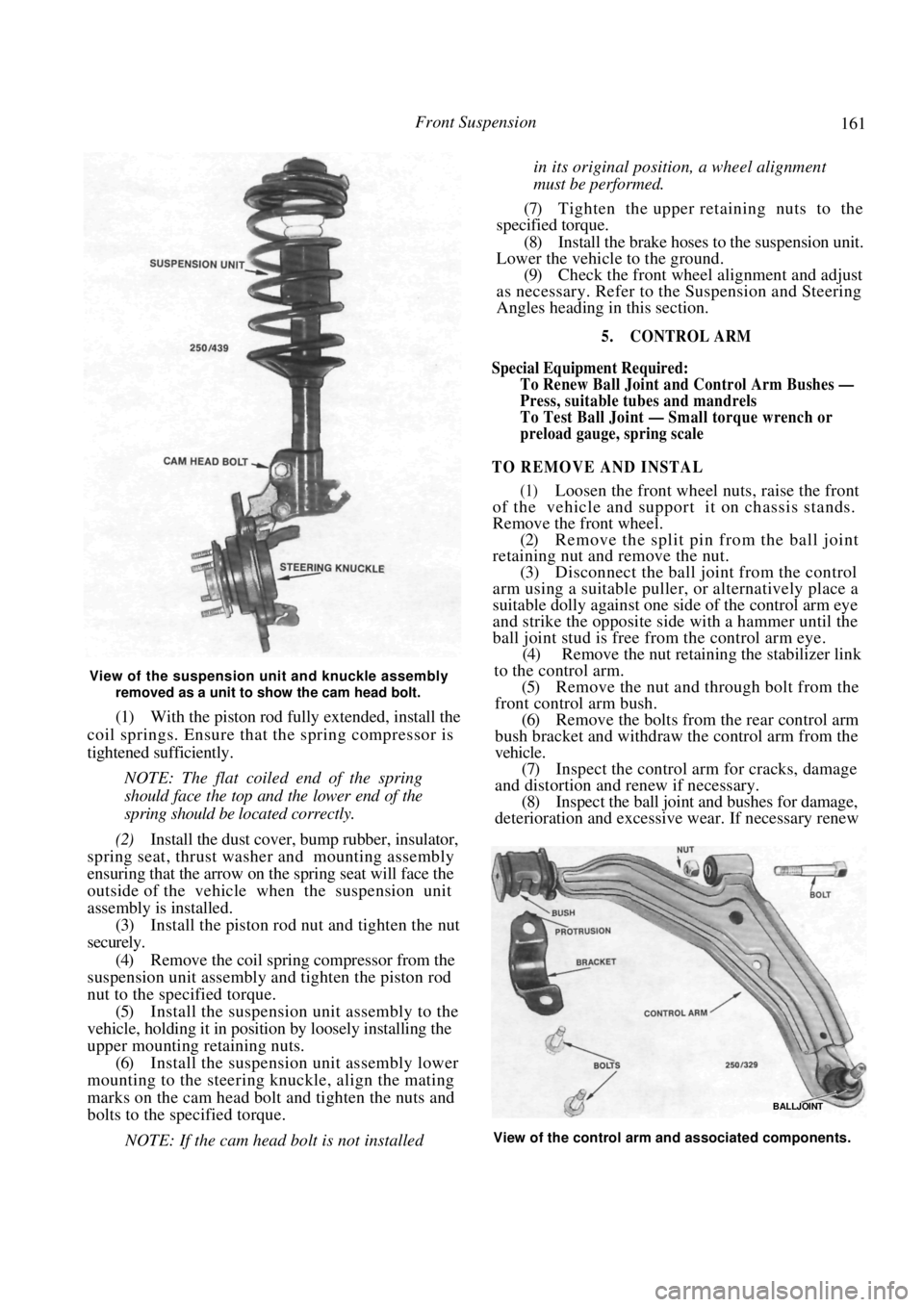
Front Suspension 161
View of the suspension unit and knuckle assembly removed as a unit to show the cam head bolt.
(1) With the piston rod fully extended, install the
coil springs. Ensure that the spring compressor is
tightened sufficiently.
NOTE: The flat coiled end of the spring
should face the top and the lower end of the
spring should be located correctly.
(2) Install the dust cover, bump rubber, insulator,
spring seat, thrust washer and mounting assembly
ensuring that the arrow on the spring seat will face the
outside of the vehicle when the suspension unit
assembly is installed.
(3) Install the piston rod nut and tighten the nut
securely.
(4) Remove the coil spring compressor from the
suspension unit assembly and tighten the piston rod
nut to the specified torque. (5) Install the suspension unit assembly to the
vehicle, holding it in position by loosely installing the
upper mounting retaining nuts. (6) Install the suspension unit assembly lower
mounting to the steering knuckle, align the mating
marks on the cam head bolt and tighten the nuts and
bolts to the specified torque.
NOTE: If the cam head bolt is not installed
in its original position, a wheel alignment
must be performed.
(7) Tighten the upper retaining nuts to the
specified torque.
(8) Install the brake hoses to the suspension unit.
Lower the vehicle to the ground.
(9) Check the front wheel alignment and adjust
as necessary. Refer to the Suspension and Steering
Angles heading in this section.
5. CONTROL ARM
Special Equipment Required:
To Renew Ball Joint and Control Arm Bushes —
Press, suitable t ubes and mandrels
To Test Ball Joint — Small torque wrench or
preload gauge, spring scale
TO REMOVE AND INSTAL
(1) Loosen the front wheel nuts, raise the front
of the vehicle and support it on chassis stands.
Remove the front wheel.
(2) Remove the split pin from the ball joint
retaining nut and remove the nut.
(3) Disconnect the ball joint from the control
arm using a suitable puller, or alternatively place a
suitable dolly against one si de of the control arm eye
and strike the opposite side with a hammer until the
ball joint stud is free from the control arm eye. (4) Remove the nut retaining the stabilizer link
to the control arm.
(5) Remove the nut and through bolt from the
front control arm bush. (6) Remove the bolts from the rear control arm
bush bracket and withdraw the control arm from the
vehicle. (7) Inspect the control arm for cracks, damage
and distortion and renew if necessary. (8) Inspect the ball joint and bushes for damage,
deterioration and excessive wear. If necessary renew
BALLJOINT
View of the control arm and associated components.